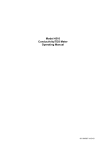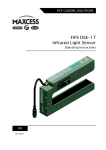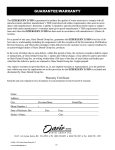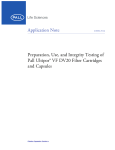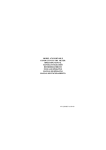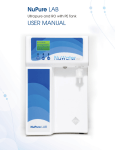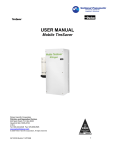Download USER MANUAL - ANS America
Transcript
USER MANUAL Advantage™ Nitrogen Generator Models: ANS20F ANS34F ANS America Corporation 1112 North Collier Boulevard Marco Island, FL 34145 Tel: 239-394-6099 Fax: 239-394-5388 www.ans-america.com Copyright© 2007 ANS America Corporation -1- Table of Contents 1. INTRODUCTION 3 1.1 GENERAL ............................................................................................................................................... 3 1.2 PICTOGRAMS IN THIS MANUAL .............................................................................................................. 3 1.3 IDENTIFICATION AND SERVICE ............................................................................................................... 4 1.4 USE IN ACCORDANCE WITH PURPOSE ..................................................................................................... 4 1.5 USER INSTRUCTIONS .............................................................................................................................. 4 1.6 LIABILITY .............................................................................................................................................. 4 2 HEALTH, SAFETY AND ENVIRONMENTAL ASPECTS 5 2.1 GENERAL ............................................................................................................................................... 5 2.2 COMPRESSED AIR .................................................................................................................................. 5 2.3 NITROGEN AND OXYGEN ....................................................................................................................... 5 2.4 SAFETY PRECAUTIONS ........................................................................................................................... 6 2.5 ENVIRONMENTAL ASPECTS .................................................................................................................... 6 3 DESCRIPTION OF THE APPLIANCE 7 3.1 GENERAL ............................................................................................................................................... 7 3.2 SEPARATION PRINCIPLE ......................................................................................................................... 7 3.3 PROCESS PARAMETERS .......................................................................................................................... 8 3.4 PROCESS SCHEMES ................................................................................................................................ 9 4 TECHNICAL SPECIFICATIONS 10 4.1 GENERAL ............................................................................................................................................. 10 4.2 REPLACEMENT PARTS ......................................................................................................................... 10 5. INSTALLATION 11 5.1 TRANSPORT ......................................................................................................................................... 11 5.2 DEFINE LOCATION ............................................................................................................................... 11 5.3 UNPACK AND CHECK EQUIPMENT (REFER TO SECTION 5.3.1) ............................................................. 11 5.3.1 PARTS CHECKLIST ............................................................................................................................ 11 5.3.2 ITEMS REQUIRED BY CUSTOMER FOR PROPER INSTALLATION: .......................................................... 12 5.4 CONNECT PREFILTRATION PACKAGE TO ADVANTAGE NITROGEN SYSTEM ......................................... 12 5.5 CONNECTION TO COMPRESSED AIR FEED AND NITROGEN CONSUMER .................................................. 13 5.6 COMMISSIONING OF AN ADVANTAGE NITROGEN SYSTEM .................................................................. 14 5.7 ADJUSTING THE PURITY ....................................................................................................................... 14 5.8 ADJUSTING THE PNEUMATIC PRESSURE SWITCH (OPTIONAL) .............................................................. 14 6 OPERATION 16 6.1 START-UP OF ADVANTAGE NITROGEN SYSTEM ................................................................................... 16 6.2 STOP OPERATION OF ADVANTAGE NITROGEN SYSTEM........................................................................ 16 6.3 TROUBLESHOOTING ............................................................................................................................ 16 7 MAINTENANCE 17 7.1 MAINTENANCE SCHEME ...................................................................................................................... 17 7.2 REPLACE FILTER ELEMENT .................................................................................................................. 17 7.3 CLEAN AUTOMATIC DRAIN .................................................................................................................. 18 7.4 REPLACE CARBON ............................................................................................................................... 18 -2- 1. Introduction 1.1 General The Advantage Nitrogen System is a product of ANS America Corporation. This manual forms an integral part of the product. The manual describes the daily operation, maintenance required and troubleshooting techniques, if necessary. Content Read the manual carefully before you start with the Advantage Nitrogen System. Familiarize yourself with the content. Condition of change Only execute changes to the Advantage Nitrogen System after explicit prior written permission by ANS America. Non-conformance to this rule, as well as any consequential damage, loss and costs are the responsibility of the owner and the user. Information All information in this manual, including additional drawings and technical descriptions, remains the property of ANS America Corporation and may not be used (other than for the use of this product), copied, multiplied or published to or for a third party without explicit prior written permission by ANS America Corporation. 1.2 Pictograms in this manual In this manual the following pictograms are used: Warning A warning shows a hazard that can cause death or serious injury. Follow the instructions. Caution A caution shows a danger that can cause damage to the equipment. Follow the instructions. Warning Risk of death due to suffocation. Risk of fire Oxygen-enriched air leads to an increased risk of fire in the event of contact with inflammable products. High pressure risk Follow the instructions with respect to compressed gasses. Instructions with respect to the environment. -3- 1.3 Identification and service The identification plate is located on the left side of the Advantage Nitrogen System and shows its characteristics. For service and technical assistance, please contact: ANS America Corporation 1112 North Collier Boulevard Marco Island, FL 34145 Tel: 239-394-6099 Fax: 239-394-5388 www.ans-america.com 1.4 Use in accordance with purpose The Advantage Nitrogen System nitrogen generator is intended to make nitrogen out of normal ambient air. The system is based on gas separation membrane technology. Each different or further use will not be in conformity with this purpose. ANS America will not accept any liability for improper use. The Advantage Nitrogen System nitrogen generator is in compliance with the prevailing directives and standards. Only use this Advantage Nitrogen System in a technically perfect condition, in conformity with the purpose as described above. 1.5 User instructions Only properly trained personnel are allowed to work on the Advantage Nitrogen System nitrogen generator. The user must be aware of hazards related to operating the Advantage Nitrogen System and processes connected to it. The user is responsible for the safety of personnel nearby. All personnel working on the Advantage Nitrogen System must have free access to the applicable manuals. 1.6 Liability ANS America Corporation will not accept any liability if: o The instructions in this manual are ignored. o Replacement parts are used which are not approved by the manufacturer. o The system is operated incorrectly. o The system is fed with gasses other than air. o The system is modified without notification and authorization of the manufacturer. o Maintenance and repair are not carried out according to the instructions. -4- 2 Health, safety and environmental aspects 2.1 General Correct use of the Advantage Nitrogen System nitrogen generator is important for your personal safety and for trouble-free functioning of the Advantage Nitrogen System. Incorrect use can cause damage to the Advantage Nitrogen System or can lead to incorrect gas supply to the customer’s process. Warning o Read this manual before you start the installation and begin operation of the Advantage Nitrogen System. Prevent accidents and damage to the Advantage Nitrogen System. o Contact your supplier if you detect a problem that you cannot solve with this manual. o Use the Advantage Nitrogen System in accordance with its purpose. Refer to section 1.4. o Only service-engineers that are qualified to work on pneumatic equipment are allowed to do the installation, maintenance and repairs. Refer to section 1.5. o Do not tamper or experiment with the equipment. Do not exceed the technical specifications for the Advantage Nitrogen System. Refer to section 4.1. 2.2 Compressed air Warning o Ensure that the feed air pressure can not exceed 190 psig. o Ensure that the equipment and the attendant piping is connected correctly for the pressures required. o Depressurise the Advantage Nitrogen System and the connected systems before you disconnect parts of the system. The sudden escape of compressed air can cause serious injury or damage. Refer to section 6.2. 2.3 Nitrogen and oxygen The Advantage Nitrogen System generates nitrogen as a product. Oxygen enriched air is released as waste. Warning o o o Nitrogen can cause suffocation! Oxygen-enriched air leads to increased risk of fire in the event of contact with flammable products. Make sure that there is adequate ventilation at all times! Do not install the Advantage Nitrogen System in an area where explosive substances may be present. -5- 2.4 Safety precautions Warning o o o o o o o Ensure there is sufficient ventilation. Only feed the Advantage Nitrogen System with air. Keep the air feed to the Advantage Nitrogen System clean and free of vapors of organic solvents and other contaminants. Do not place the Advantage Nitrogen System in a room where organic solvent vapors may be present. Keep the ambient temperature between 40 and 110 °F. Do not connect hot compressed air directly from a compressor to the inlet of the Advantage Nitrogen System. Install the peripheral equipment and piping according to all applicable local regulations. ANS America Corporation is not responsible for customer installed piping. Regular maintenance should be performed on the Advantage Nitrogen System to ensure proper and safe operation. Refer to chapter 7. Ensure that instructions concerning health and safety are compliant with local regulations. 2.5 Environmental aspects The use and maintenance of the Advantage Nitrogen System do not include environmental dangers. Most parts are made of metal and can be disposed of in a manner consistent with local regulations. The packaging of the Advantage Nitrogen System is 100% recyclable. o Make sure that instructions concerning health, safety and environment are compliant with all local regulations. -6- 3 Description of the appliance 3.1 General The Advantage Nitrogen System separates compressed air into nitrogen and an oxygen enriched air stream. The separation system is based on membrane technology. The compressed air comes from a central system or from a dedicated compressor. The nitrogen produced is usually stored in a nitrogen storage vessel. The Advantage Nitrogen System then switches on and off, depending on the nitrogen demand. 3.2 Separation principle Separation layer Support layer B Pressurised air Nitrogen C A H2 O, H2 O2 N2 S F Fig. 3-1: Separation principle A B C Pressurized air inlet Hollow fibre membrane Nitrogen outlet F S Fast Slow Ambient air contains nitrogen (78.1%), oxygen (20.9%), argon (1%), carbon dioxide, water vapor and traces of other inert gasses. Pressurised air (A) is fed through the hollow fibre membrane (B). The various air components diffuse through the wall of the membrane. The diffusion rate differs for the various gasses: • Oxygen and water vapor have a high diffusion rate and permeate rapidly through the membrane wall. • Nitrogen has a low diffusion rate and permeates slowly through the membrane wall. At the exit of the membrane (C), pressurized nitrogen is released. -7- 3.3 Process parameters The nitrogen production depends on these parameters: Flow rate The lower the flow rate of compressed air through the hollow fibre membrane, the more oxygen can permeate through the membrane wall. As a result, the nitrogen produced at the outlet will have a higher purity. Nitrogen purity can be adjusted with the flow control valve. Temperature The Advantage Nitrogen System operates optimally at a temperature between 68-80°F. If the temperature increases, the pressurized air consumption will also increase. Do not place the system in a room where the temperature may rise unnecessarily high. Allow enough piping between the compressor exit and the Advantage Nitrogen System inlet so that the hot compressed gas has time to cool within the specifications listed in this manual. Membrane pressure A higher membrane pressure will increase the capacity (i.e. nitrogen output) of the Advantage Nitrogen System. Pressure also enables operation of the pneumatic shut-off switch. External pressure There must be atmospheric pressure at the vent or permeate outlet. The capacity and the purity of the nitrogen gas decreases strongly if the vent or permeate pressure exceeds the atmospheric pressure. -8- 3.4 Process Schemes 3.4.1 Models ANS-20F, ANS-34F Permeate Outlet PRV PSH Inlet F-01 F-02 DX BX F-02 C Product BX V-2 V-1 FCV V-3 M-1, M-2 ... PI-1 F-01, F-02 Coalescing filter V-1 Ball valve M-1, M-2, ... Gas separation membrane FCV Flow control valve V-2 Valve C Activated carbon bed PI-1 Pressure gauge PSH Pressure switch ST Storage tank PRV Pressure relief valve V-3 Non-return valve ST -9- 4 Technical specifications 4.1 General Delivery pressure Maximum delivery pressure Compressed air Maximum feed pressure Minimum feed pressure Compressed air temperature range Residual oil content Atmospheric dew point Air Consumption ANS-20F ANS-34F Inlet pressure minus 15 psi 145 psi(g) / 13 bar(g) 145 psig 50 to 104 °F (10°C to 40°C) < 0.01 mg/m3 -50 °F(-45.6°C) 45.5 SCFM 88.4 SCFM Ambient conditions Temperature Noise level Dimensions and connections Dimensions Net weight Connections inlet Outlet (tank) Storage Tank Dimensions Storage Tank Weight Output Capacity at nominal conditions(2) Purity at specified capacity [% by volume] 33 to 110 °F Less than 45 dB(A) 33”H x 22”W x 6”D 69”H x 24”W x 20”D 88 lbs. 210 lbs. ½” NPT 3/4” NPT ½” NPT ½” NPT 40”H x 18”D (30 gal. tank) 125 lbs. (30 gal. Tank) 20 SCFM 34 SCFM 95 1 Nominal conditions are 145 psig supply air pressure, 68°F ambient air temperature. Table 4-1: General data 4.2 Replacement Parts Part • ANS-20F Maintenance Kit P/N MK-ANS- • MK-TS24F ANS-34F Maintenance Kit - 10 - 5. Installation Follow the sections in this chapter to install the Advantage Nitrogen System. 5.1 Transport Warning o o Put the Advantage Nitrogen System in the original box to transport it over longer distances. For qualifications of installation personnel, refer to section 2.1. 5.2 Define location 1. Install the Advantage Nitrogen System in a fixed location. The location must meet following requirements: • Indoors. • Dry. • Vibration free. • No continuous, direct sunlight. • Away from heat sources. • Properly ventilated room. Refer to section 2.4. • Easy accessibility for operation and service. Perform the complete installation procedure again if you move the Advantage Nitrogen System to a new location. 5.3 Unpack and check equipment (refer to section 5.3.1) 1. Open the packaging. 2. Ensure that all components are delivered. 3. Ensure that the available compressed air meets specification: • Oil content of the compressed air is below 0.01mg/m3. • If the Advantage Nitrogen System is connected to a house air system: ensure that the compressed air pressure and quality is always as prescribed. The capacity must be sufficient. • If the Advantage Nitrogen System is connected to a stand-alone compressor: ensure that the compressor works properly. Refer to the instructions of the compressor manufacturer. Ensure that the after cooler and the water separator of the compressor work correctly. • If installed, ensure that the pressurised air dryer is of proper size and that it is in working order. 5.3.1 Parts Checklist Items included in the package: 1. Advantage Nitrogen System Nitrogen Generator. 2. Installation and operation manual. 3. [ANS-34F] Prefiltration package consisting of two coalescing filters and a carbon adsorption tower. Hose is included for connecting systems together. 4. [Optional] Nitrogen Storage Tank. Tank has pressure relief valve located on top – DO NOT REMOVE or ADJUST. A green hose is included to connect outlet of the generator to the storage tank. 5. [Optional] Point of sale materials. - 11 - 5.3.2 Items required by customer for proper installation: 1. Suitable way to attach process air from plant to the inlet of the prefiltration package [ANS-34F] or to the Advantage Nitrogen System generator directly [ANS-20F]. The inlet connection for the ANS-20F is ½” FNPT (see section 4.1). The ANS-34F inlet connection is ¾” FNPT. 2. Suitable connection from nitrogen storage tank to customer’s tire filling hoses or manifold. The tank exit connection is ½” FNPT. For multiple nitrogen hose drops, considering installing a pipe Tee or some sort of manifold if one does not already exist. 3. Use PTFE pipe seal tape or other suitable thread sealant for the NPT thread connections. Note: the hose connections for the included ½” green hose seal with special flare fittings – do not use any sort of thread sealant on these connections. It is sufficient to ensure that they are tight for a leak-free connection. 4. It is recommended to install a drip leg on the inlet side of the system to catch loose particles in the piping system. Consult a local plumber for assistance if needed. 5. Mounting dimensions or system footprint: Figure 5.1: Mounting Dimensions ANS-20F, ANS-34F (Top View) 5.4 Connect Prefiltration Package to Advantage Nitrogen System The Carbon Absorber for the Advantage Nitrogen System includes two stages of coalescing prefiltration and an activated carbon adsorption bed. Use the supplied rubber hose to connect the outlet of the carbon bed to the inlet of the Advantage Nitrogen System (see Figure 5.3). The prefiltration package for the ANS-20F is located inside the cabinet; for the ANS-34F it is a stand-alone tower. See Figure 5.3. - 12 - 5.5 Connection to compressed air feed and nitrogen consumer Warning o Make sure that the inlet and outlet hose and pipe are free of dust, particles, metal parts and curls, liquids and grease before you connect the Advantage Nitrogen System. 1. Connect the product outlet to the application or storage vessel. 2. [ANS-20F] Connect the compressed air supply to the compressed air inlet (see Figure 5.2). 3. [ANS-34F] Connect the compressed air source to the inlet of the first filter (see Figure 5.3). Figure 5.2: Installation Schematic ANS-20F Figure 5.3: Installation Schematic ANS-34F (ANS-20F: Carbon tower/prefiltration interval) - 13 - 5.6 Commissioning of An Advantage Nitrogen System 1. 2. 3. 4. 5. Ensure that the connections are correct and tightened. Open the compressed air supply slowly. Ensure that the compressed air pressure is as high as expected. Ensure that the installation has no leaks which may have arisen due to transport. Ensure that the system starts to consume pressurised air when the nitrogen outlet is opened and that air consumption stops when the nitrogen outlet is blocked again. 6. The system is ready for use now. 5.7 Adjusting the purity The purity is factory pre-set at 97%, which means that there is 5% residual oxygen. The purity has been set by adjusting the flow control valve. Normally the setting is stable and does not need to be checked. If it becomes necessary to adjust the purity, this can be done by adjusting the flow control valve until the purity, as measured with an oxygen analyzer taking a sample from the outlet, has the desired purity. 5.8 Adjusting the pneumatic pressure switch (Optional) The pressure switch (PSH or “Pilot Valve”) is factory pre-set to 130 psig such that the Advantage Nitrogen System switches off when there is no consumption and that it switches back on when there is consumption of nitrogen. Note that the pressure switch will always leak a small amount of air. Important Adjusting the pressure switch set point is required for successful installation of the Advantage Nitrogen System system, if operated at Inlet condition lower than the factory set point as described above. o o If the switch set point is set too high, the supply will never turn off, and the compressor will run constantly. If it is set too low, the Advantage Nitrogen System will not take advantage of all of the pressure available from your compressed air supply. The system will operate reliably, just not at maximum capacity and pressure. Upon commissioning the system, allow the system to run so that the storage tank fills. After a period of time, the nitrogen storage pressure should stop rising, the system turns off, and there is no more demand for air from your compressor. If the compressor/system does not shut off, the pressure switch is set too high and the set point on the pressure switch needs to be reduced so the system turns off. If the compressor shuts off as expected, there may be an opportunity to increase the performance of your system. If your compressor is capable of high PSI/CFM you may want to try to increase the set point on the pressure switch set. This will increase the pressure of nitrogen in the storage tank that is available for filling tires. - 14 - Warning Never set the pressure switch so that the technical specifications of the Advantage Nitrogen System are exceeded; this can cause serious injury and/or damage (see Chapter 4.1 for specifications). The maximum pressure setpoint in the tank is 145 psig. DO NOT EXCEED THIS PRESSURE. The pressure switch is as shown: To Adjust: 1. Loosen lock-nut 1. 2. The set point for the pressure switch can be increased by turning the pressure rod at the finger grip clockwise and decreased by turning it counter-clockwise. Be careful with turning the pressure rod counter-clockwise. If you loosen too much the pressure rod could back all the way out. When decreasing the pressure set point, turn the pressure rod counter clock-wise until the system turns off, then turn counter clockwise another ¼ of a turn to ensure the compressor will shut off. 3. The differential screw does not need adjustment. Erroneous setting causes the pressure switch to pop repeatedly. Should its setting be changed erroneously, reset it as follows. A. Loosen lock-nut 2. B. Turn the differential screw clockwise until it can go no further and turn it counterclockwise ¼ turn. 4. Retighten all locknuts, being careful not to twist pressure rod. Once the set point is adjusted, it is important to test the system as follows. Allow some nitrogen to vent from the storage vessel (e.g. open a valve slowly) until the compressor/system turns back on. Close the vent source, and see if system turns off. If so, the set point is adjusted correctly, retighten lock nut on adjustment screw. If the compressor/system does not shut off, you will need to lower the set point slightly until the compressor/system shuts off. It is recommended to repeat this test 3 times to ensure that the set point on the pressure switch is set correctly. - 15 - 6 Operation 6.1 Start-up of Advantage Nitrogen System 1. Open the compressed air supply. 2. The system will start to produce nitrogen as soon as the nitrogen outlet is opened. The specified purity will be available instantaneously. 6.2 Stop operation of Advantage Nitrogen System 1. Shut off the pressurised air supply before you perform maintenance. 2. Depressurise the system by venting the nitrogen outlet. 3. Ensure that the system is fully depressurised by checking the pressure gauge. TIP: should the filters not be fully depressurized it is possible to depressurize them manually by slowly unscrewing the bleed screw on the bottom of the filter bowl on one of the filters. Prior to reinstalling the bleed screw after venting, ensure the o-ring is seated properly. It may be necessary to vent the filters all the way down to atmospheric pressure so that the o-ring will seat. 6.3 Troubleshooting Error Delivery of nitrogen too low or absent Possible cause Compressed air supply too low Ambient temperature is too high Compressed air temperature is too high Air filters are polluted Leak in piping Automatic drain is continuously open Nitrogen outlet line is blocked. Blockage Advantage Nitrogen System does not automatically switch off Feed pressure too low Ambient temperature is too high Compressed air temperature is too high Air filters are polluted Leak in piping Nitrogen outlet is open Automatic drain is continuously open Possible solution Check/increase the air supply. Lower the temperature, if possible. Lower the temperature, if possible. Change the air filters. Check for leaks in piping; repair. Check the automatic drain. (chapter 7) Check/open the outlet line. Check the compressed air delivery to the compressor. Increase feed pressure; adjust setpoint of pressure switch. (chapter 5.8) Lower the temperature, if possible. Lower the temperature, if possible. Change or clean the air filters. Check for leaks in the piping; repair. Close outlet. Check the automatic drain. (chapter 7) - 16 - 7 Maintenance 7.1 Maintenance scheme Part Filter Action Replace filter element. Refer to section 7.2 Automatic drain Carbon Absorber Clean automatic drain. Refer to section 7.3 Replace carbon. Refer to section 7.4 Frequency 1x per year, or when indicator on the filter head reaches the end of the indicator bar When required Together with the filter elements, 1x per year Table 7-1: Maintenance scheme 7.2 Replace filter element 1. Turn off the air supply. 2. Let the system depressurize until the pressure gauge at (see Figure 3.4.1) reads 0 psi. 3. Unscrew the bleed screw (F) slowly to ensure that the filter is depressurized. 4. Turn the filter bowl (E) counter- clockwise and pull the bowl from the filter housing (A). 5. Unscrew the blue knob (D). 6. Remove the old filter element (C). 7. Clean the sieve (B) and the filter house, if necessary. 8. Install a new filter element (C). 9. Assemble the parts in the reverse order. Fig. 7-2: Replace filter element - 17 - 7.3 Clean automatic drain 1. Open the filter by untwisting the bowl ¼ turn counter-clockwise. 2. Unscrew the nut (F). 3. Remove the drain unit (B-E) from the filter bowl (A). 4. Remove the O-ring (E). 5. Carefully pull the floating house (B) from the seat (D). Do not bend the needle (C). 6. Clean the parts with soap and water. Make sure that the needle bore is open and clean. 7. Assemble the parts in the opposite direction. Make sure that the parts are dry before reassembly. Fig. 7-3: Clean drain filter 7.4 Replace carbon Model ANS-20F, ANS-34F: Follow steps as in section 7.2 to replace the carbon element. Models ANS-20F: Open front access panel. Replace the carbon tube on bracket by removing hoses and unscrewing the tube from the bracket. Replace with new tube. Model ANS-34F: See installation and operation manual which comes with the stand alone carbon absorber. - 18 -




















